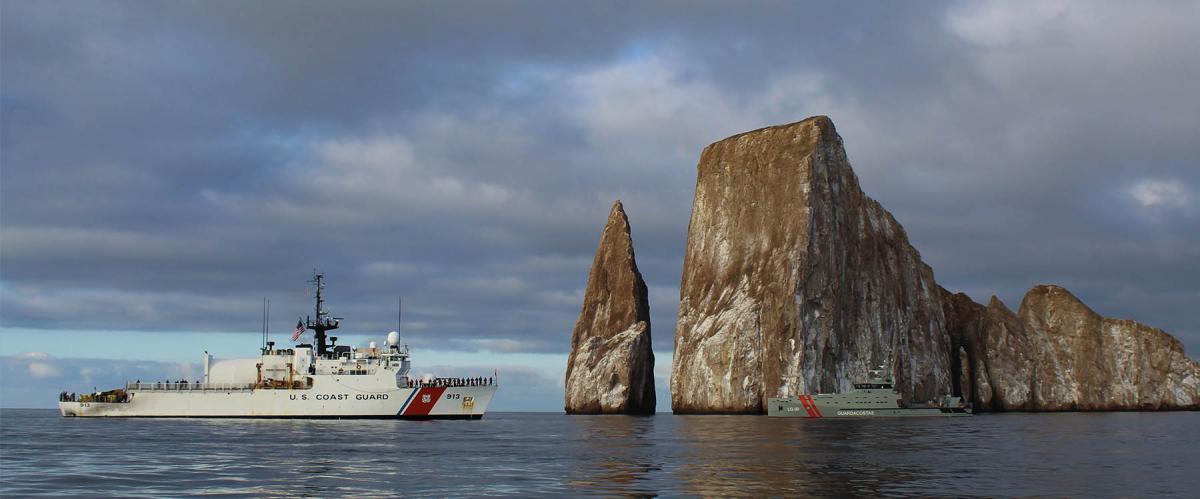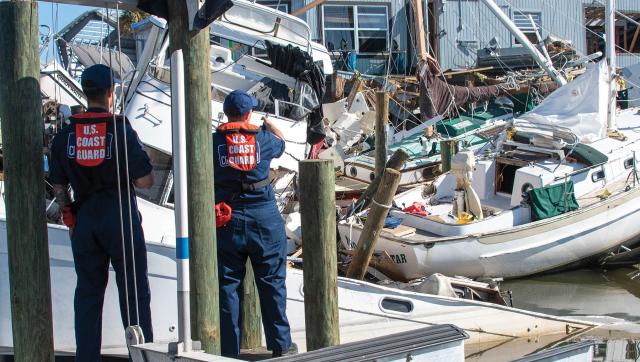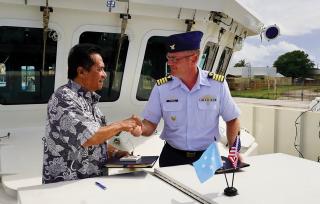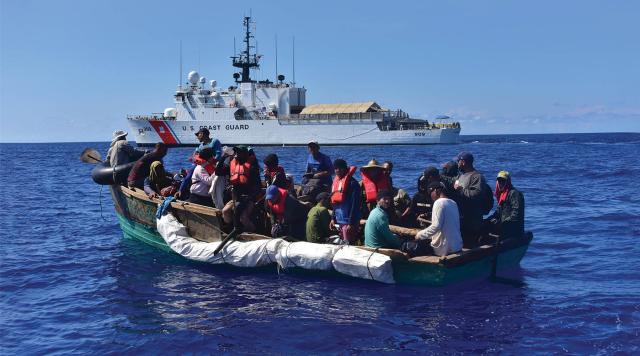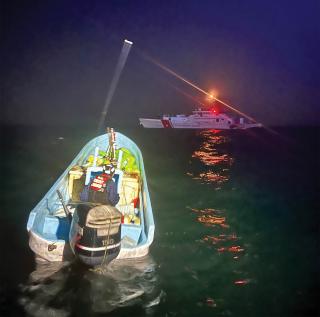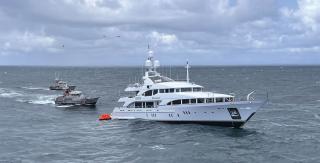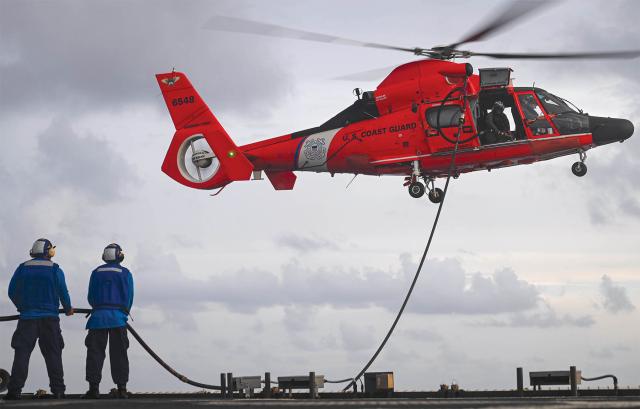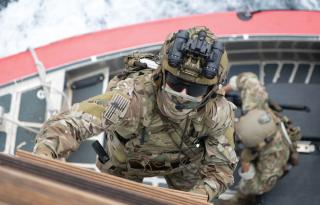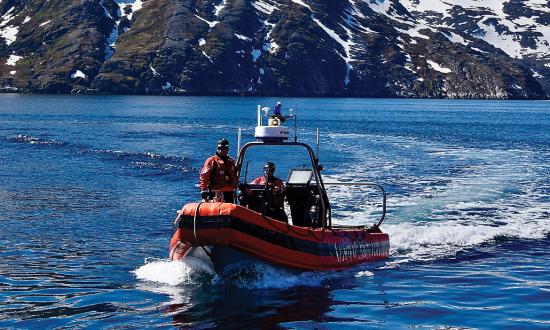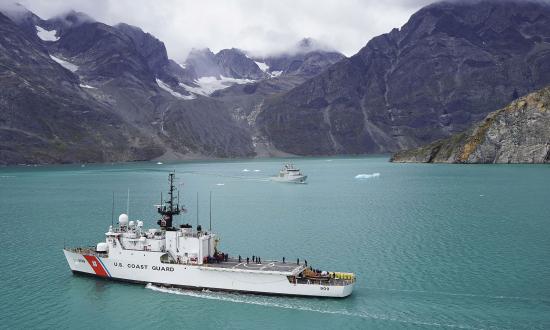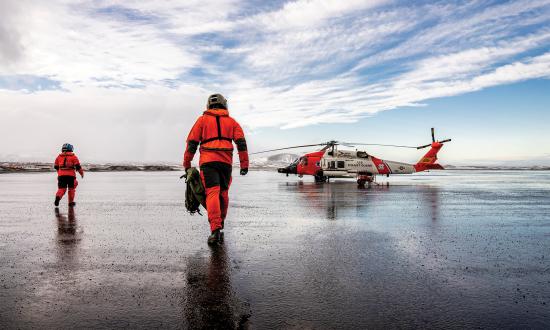On 1 June 2022, Coast Guard Commandant Admiral Karl Schultz turned over the helm to Admiral Linda Fagan, the first woman to lead a branch of the U.S. armed forces. President Joe Biden noted the significance, stating simply, “It’s about time.”
With new leadership came a new vision, a new strategy, and a sense of excitement. Within hours of assuming command, Admiral Fagan released Commandant’s Intent 2022, noting, “Tomorrow looks different. So will we. We will be a more adaptive and connected Coast Guard that generates sustained readiness, resilience, and capability in new ways to enhance our nation’s maritime safety, security, and prosperity.”1 The Intent focuses on developing and supporting the workforce, sharpening the service’s competitive edge with investments in technology and infrastructure, and advancing mission excellence by pioneering new operating concepts.
In October, a complementary service strategy also was released. “The transformation called for in this Strategy is foundational to the success of our Coast Guard,” it notes. The strategy calls on Coast Guard men and women to think differently, innovate for results, and learn from their successes and failures: “We will balance boldness with warranted risk; the status quo will no longer serve us as we look to the future.”2
Because the workforce is the foundation of all Coast Guard efforts, recruiting was a prime issue in 2022. An ALCOAST message from early in the year included a note from then–Commandant Schultz “calling on every member of our Coast Guard—military, civilian, Auxiliary, retiree, and family—to put forth a maximum effort to recruit the workforces of our future.” Admiral Fagan and her team took this message and ran with it, establishing the “Scout Talent and Refer” (STAR) program. The program extended participation to include Coast Guard retirees and Auxiliary members and increased from $500 to $1,000 the incentive for a referral that results in an enlistment.3
Appearing before the House Subcommittee on Coast Guard and Maritime Transportation, Admiral Fagan noted, “Our workforce is the heartbeat of the Coast Guard, and without them, we cannot execute missions. My highest priority as a Commandant is to transform our talent management system . . . to better serve our people in the 21st century.”4
In addition to the changes underway based on the new strategy, the service continued its traditional missions: search and rescue, law enforcement, marine safety, and operations with the Department of Defense (DoD). Mother Nature also ensured the Coast Guard was in high demand in 2022. On top of hurricanes, the low water level of the nation’s river system, a vital artery for economic output, played havoc with efforts to move commerce. On 1 October alone, eight barge groundings were reported by Coast Guard Sector Lower Mississippi River.
Hurricane Ian
With winds that peaked at 155 mph, Hurricane Ian was the most destructive storm of the 2022 Atlantic hurricane season. As Ian set its sights on Florida, Coast Guard personnel began preparing to respond. The storm made landfall on 28 September as a Category 4 (the fifth strongest in U.S. history), coming ashore near Fort Meyers.
Coast Guard units were in the air and underway almost immediately rescuing people in distress—including those on Sanibel Island and other barrier islands whose main causeways were reduced to twisted steel. During a 1 October interview with NBC’s Today show, Rear Admiral Brendan McPherson, Coast Guard Seventh District commander, noted, “Just hours after the storm made landfall, we’ve been able to rescue about 325 people and more than 100 pets.”5
Law Enforcement
One of the tools in the Coast Guard’s law enforcement toolbox is bilateral shiprider agreements, which allow the service and international partners to operate together to observe, board, and search vessels suspected of illegal activities within a designated exclusive economic zone or on the high seas. In late 2022, the latest shiprider agreement was completed with the Federated States of Micronesia (FSM).
“This historic agreement significantly strengthens presence and enforcement options to counter illicit maritime activity in the region. It is only made possible by the deep and abiding relationships and respect between the Coast Guard and our FSM partners,” said Captain Nick Simmons, Commander of U.S. Coast Guard Forces Micronesia and Sector Guam.6
Other bilateral shiprider agreements are closer to home. On 4 May, members of the Coast Guard and Royal Canadian Mounted Police shiprider program, a collaborative cross-border effort, arrested individuals on board a stolen Canadian sailboat. The team was conducting a patrol when they encountered a 26-foot sailboat near the U.S.-Canadian maritime border that appeared to have no power. Neither of the men on board was the registered owner of the boat, and one was wanted in British Columbia on an outstanding warrant. After the sailboat returned to Canadian waters, the shiprider crew boarded and arrested the man.
Sector Columbia River’s Lieutenant Commander Colin Fogarty led a 2022 effort to identify “paper captains” among Washington state’s fishing fleet. Under section 46 of the U.S. Code, a U.S.-flagged vessel must be under the command of a U.S. citizen; a paper captain is an individual listed on a vessel’s documents as captain but who actually serves in a lower-level capacity. Unfortunately, fishing vessels often hire illegal foreign nationals to serve as captains. These violations frequently are supported by additional fraudulent documents designed to avoid detection, and the vessels often also have multiple safety issues. Lieutenant Commander Fogarty’s efforts led to significant penalties for violators.
On the counternarcotics front, the 270-foot USCGC Mohawk (WMEC-913), while deployed to the eastern Pacific in support of Joint Interagency Task Force South (JIATF South), intercepted a low-profile vessel carrying 3,200 pounds of cocaine valued at $60 million. Earlier in the year, the USCGC Legare (WMEC-912) returned to Miami with more than $475 million of illegal narcotics, including 24,700 pounds of cocaine and 3,892 pounds of marijuana. According to U.S. Southern Command, this offload was a collection of busts not only by Legare, but also by:
• HNLMS Groningen of the Royal Netherlands Navy and embarked U.S. Coast Guard Law Enforcement Detachment (LEDet)101
• The USS Billings (LCS-15) and embarked LEDet 401
• The USCGC James (WMSL-754)
Two other counternarcotics efforts were more unusual. The first was a bust accomplished by fast response cutters in Patrol Forces Southwest Asia. The USCGC Glen Harris (WPC-1144) intercepted $85 million in drugs. The second was a joint Coast Guard and Customs and Border Protection (CBP) effort pierside in Seattle, in which 20,000 pounds of dried khat, a Schedule 1 narcotic, was intercepted. Valued at $3.6 million, the drugs originated in Kenya labeled as “tea.” According to CBP, khat contains cathinone, which is known to be very addictive and is classified as a controlled substance in the United States. This kind of joint interdiction underscores the ability of all Coast Guard units to thrive in a multijurisdictional, multiagency environment.
Fisheries
One unique interdiction of 2022 received virtually no press attention. In October, during Operation North Pacific Guard—an annual multiorganization and multijurisdiction collaboration of the Coast Guard, Alaska Department of Fish and Game, National Oceanic and Atmospheric Administration (NOAA), North Pacific Anadromous Fishing Commission, five Pacific Rim countries, and three regional fisheries management organizations—the participating agencies boarded 15 fishing vessels, assessing 32 potential violations. Three vessels were found to have 450 shark fins, which was a significant issue. Western and Central Pacific Fisheries Commission and North Pacific Fisheries Commission regulations require fully using retained catches of sharks and limit the amount of fins on board in relation to those sharks.
In addition, the service engaged with the Pacific Islands Forum Fisheries Agency during Operation Island Chief and the larger Operation Blue Pacific while on patrol in the western Pacific from August into September 2022. The USCGC Oliver Henry (WPC-1140) operated within the exclusive economic zones of the FSM, Papua New Guinea, Australia, and the Solomon Islands. “We are eager to further integrate with our Allies and regional partners to protect national interests and combat illicit maritime activity such as illegal, unreported, and unregulated fishing,” said Captain Nick Simmons, Coast Guard Forces Micronesia/Sector Guam commander.
The Pacific was not the only location where the service has engaged in operations to protect and secure U.S. fish stocks. In the Gulf of Mexico, illegal, unreported, and unregulated (IUU) fishing occurs only a few miles from spring breakers enjoying Texas’s South Padre Island. With the help of fixed-wing overwatch, law enforcement crews from Coast Guard Eighth District fast response cutters, patrol boats, and multimission boats recorded 87 “lancha” IUU fishing interdictions in fiscal year (FY) 2022, an 11.5 percent increase from FY21. The proliferation of IUU fishing on the Eighth District’s southernmost border is an immediate threat to U.S. living marine resources, economic stability, border security, and sovereignty. The whole-of-government effort required is manifested in the Coast Guard’s collaboration with Texas Parks & Wildlife, CBP, and NOAA Fisheries and through its growing international partnership with the Mexican Navy.
The Coast Guard continued to expand its efforts in combating IUU fishing through partnerships with U.S. Africa Command, U.S. Naval Forces Africa, and African partners. Again demonstrating the value of bilateral agreements, the Coast Guard embarked shipriders from several African nations to aid in addressing maritime challenges in their waters.
Search and Rescue/Maritime Response
The Coast Guard’s most visible mission is search and rescue (SAR). Of all the SAR cases in 2022, the one that got the most national attention occurred off the Louisiana coast. Three fishermen spent 28 hours in the water surrounded by sharks and tormented by jellyfish after their boat sank in rough seas. One fisherman, with less than 5 percent charge left on his cell phone, was able to take a screen shot of his location and text it to a friend, who then reported it to the Coast Guard. The Coast Guard used this new information to locate the three men and bring them to safety. The Coast Guardsmen involved—Lieutenant Commander Kevin Keefe, Lieutenant Katy Caraway, and Petty Officer Andrew Stone—had a reunion with two of the fishermen on NBC’s Today show.
In the Pacific Northwest, 13th District has 4,400 miles of coastline, 600 miles of inland rivers, and some of the more unusual SAR cases every year. Three in 2022 involved hikers in distress. On New Year’s Day, an MH-65 Dolphin rescue helicopter crew from Coast Guard Sector North Bend rescued two 19-year-old hikers about 32 miles east southeast of Eugene after spotting “SOS” written in the snow. An MH-60 Jayhawk helicopter crew from Sector Columbia River diverted from a training mission to rescue two hikers from a coastal cliff in Manzanita on 26 April. And on 9 August, a Coast Guard Air Station Port Angeles MH-65 rescue helicopter crew diverted from training to rescue an injured 73-year-old hiker near Cape Johnson in Olympic National Park.
Also in 13th District, MH-60 Jayhawk aircrews from Coast Guard Sector Columbia River sprang into action on 9 May to rescue seven people on board the disabled 143-foot yacht Domani, 25 miles off the Washington coast. Taking on water, the Domani exceeded the towing capacity of Coast Guard motor lifeboats. The 210-foot medium-endurance cutter Active (WMEC-618) diverted to the area and took the yacht in tow. After a nearly 24-hour transit, the crew arrived near Neah Bay and transferred the tow to a commercial tug.
On Labor Day weekend, watchstanders at Coast Guard Sector Puget Sound were notified that a float plane carrying ten people, including a child, had crashed into the waters off Whidbey Island. Good Samaritans and first responders were first on scene and recovered one fatality. The 87-foot cutters Osprey (WPB-87307) and Blue Shark (WPB-87360), 45-foot response boat–medium (RB-M) crews from Station Seattle and Station Port Angeles, an MH-65 Dolphin rescue helicopter crew from Air Station Port Angeles, and a C-27J fixed-wing aircraft and crew from Air Station Sacramento, California, joined multiple local partner agencies in the search. In total, the Coast Guard conducted 26 search sorties, searching 1,283 nautical miles of track line covering approximately 2,100 square nautical miles. Unfortunately, there were no survivors of the crash.
DoD/International
The Legend-class national security cutter Midgett (WMSL-757) led a significant amount of Coast Guard–Department of Defense engagement in 2022. Under the command of Captain Willie Carmichael, the cutter participated in Rim of the Pacific (RimPac) 2022, the world’s largest international maritime exercise.
The Midgett’s participation was the first example of a national security cutter commanding two combined task forces, successfully completing 33 joint and combined at-sea events with U.S. and foreign warships. The cutter also completed a capstone exercise, providing targeting information to ten ships, four submarines, and two autonomous vehicles acting as “hostile forces” against two coalition strike groups.
In addition, in the middle of RimPac, the Midgett responded to a real-world engine room fire on board a participating Peruvian naval vessel. The cutter brought two severely burned crew members on board for stabilizing first aid and facilitated helicopter transport ashore for higher-level medical care. Once the fire was extinguished, the Midgett towed the vessel for 60 nautical miles in challenging seas and reestablished the tow when the line parted midtransit.
“Leading a combined task force and supporting the humanitarian and disaster relief mass rescue operation during RimPac showcased the relevance of U.S. Coast Guard’s capabilities and interoperability with our partner naval services,” said Captain Carmichael.7
Following RimPac, the Midgett deployed under the Navy’s Seventh Fleet in support of Indo-Pacific Command.
During her deployment in support of JIATF South, the Mohawk conducted numerous unity exercises with forces from the Panamanian Servicio Nacional Aeronaval, as well as a passing exercise with the Armada del Ecuador offshore patrol vessel Isla San Cristobal. This deployment also included a first for the Coast Guard, as Mohawk was the first cutter to anchor and visit the Galapagos Islands. The cutter was involved in professional exchanges, underscoring the service’s contribution to strengthening the United States’ international ties.
On the other side of the world, the 225-foot buoy tender Oak (WLB-211), under the command of Lieutenant Commander Jacob Loman, participated in Exercise Argus. A Danish-led exercise that includes Denmark, France, Greenland, and the United States, the annual training event is designed to enhance international partners’ capabilities to respond to search-and-rescue and marine environmental events in the Arctic region. Experts in SAR, pollution response, emergency management, and strategic communications deployed for the exercise, exchanging best practices and furthering partnerships.
In addition to the Oak’s engagement, the USCGC Bear (WMEC-901), under the command of Commander Brooke Millard and with embarked Maritime Special Response Team personnel, participated in the Canadian-led exercise Operation Nanook, an annual exercise that allows the United States and partner nations to ensure security and enhance interoperability in North Atlantic and Arctic waters.
The USCGC Hamilton (WMSL-753) participated in a deployment in the U.S. Naval Forces Europe area of operations and was employed by U.S. Sixth Fleet to defend U.S., allied, and partner interests.
These deployments demonstrate the Coast Guard’s role as a unique element of national power. Because many friendly maritime services perform the same activities as the Coast Guard, there is an acceptance and mutual understanding that enhance alliances.
On 14 March 2022, Rear Admiral Michael Johnston, commander of the Coast Guard Ninth District, and Marc-André Meunier, Canadian Coast Guard Central Region Assistant Commissioner, signed the Great Lakes Geographic Annex agreement to support coordinated planning, preparedness, and response to pollution incidents on the Great Lakes and connecting waterways. The area of responsibility under the agreement extends along the U.S./Canadian border, from the St. Lawrence River to the western point of Lake Superior, a distance of nearly 1,500 miles.
Arctic
The medium polar icebreaker Healy (WAGB-20) made a rare trip to the North Pole in September 2022, just days before the White House issued the new National Strategy for the Arctic Region. The cutter had made the trek in 1999 after her commissioning and not again until 2015. With plans to acquire three new polar security cutters (heavy icebreakers), the Coast Guard is well positioned to help execute portions of this strategy, which calls for “regular, transparent, and consistent training, exercises, and episodic deployments with our allies and partners, as well as independently . . . [and] persistent presence in the U.S. Arctic and additional presence as needed in the European Arctic.”8
The 17th District, in concert with Alaskan Command and multiple combatant commands, plays a central role in the defense readiness and homeland defense missions in and near the Arctic region. Highlighting the capabilities of the Coast Guard to embed with DoD, the national security cutter Stratton (WMSL-752) supported Polar Dagger, part of a DoD exercise in the northern Bering Sea.9 The cutter conducted beach extractions of personnel, small boats, and more than 1,400 pounds of gear on St. Lawrence Island. The Stratton used her small unmanned aerial systems to extend line of sight communications by 40 miles over the horizon, increasing communication-relay capabilities with shore forces, and to provide intelligence, surveillance, and reconnaissance for the recovery of personnel.
In the past year the Coast Guard has observed increased activities by both Russian and Chinese warships near the Arctic region. The national security cutter Kimball (WMSL-756), on a routine patrol in the Bering Sea, encountered a Chinese Renhai-class guided-missile cruiser sailing approximately 75 nautical miles north of Kiska Island in Alaska. The Kimball later identified two more Chinese and four Russian naval vessels, including a Russian Navy destroyer, all in formation with the Renhai-class cruiser, operating in the U.S. exclusive economic zone. “While the formation has operated in accordance with international rules and norms, their presence demonstrates a national security concern that the USCG intends to consistently address with Operation Frontier Sentinel,” noted District 17 Commander Rear Admiral Nathan Moore. “We will meet presence with presence and ensure there are no disruptions to U.S. interests in the maritime environment around Alaska.”10
New Acquisitions
Work continues on vital acquisition projects, including the offshore patrol cutter (OPC), fast response cutter (FRC), and polar security cutter (PSC). According to a February 2022 Congressional Research Service report, “The PSC program has received a total of $1,754.6 million in procurement funding through FY2021. . . . With [that] funding . . ., the first two PSCs are now fully funded.”11 During the 2022 State of the Coast Guard address, Admiral Schultz announced that the first new heavy polar icebreaker in more than 45 years will be named the Polar Sentinel.
The Coast Guard took delivery of the USCGC Clarence Sutphin Jr. (WPC-1147), last of the six FRCs designated for home port in Manama, Bahrain, as part of Patrol Forces Southwest Asia. These new cutters are replacing the 110-foot Island-class patrol boats. In September, the first New England–based FRC, the William Chadwick (WPC-1150) arrived in Boston. Named for the former leader of the Green Island Lifeboat Station in New Jersey who was awarded the Gold Life Saving medal, the William Chadwick ultimately will be joined by five more FRCs.
The Coast Guard Waterways Commerce Cutter Program was awarded to Denver-based Birdon America. This is a contract for design and construction of river buoy and inland construction tenders. According to the Coast Guard, the initial award is valued at $28.49 million, with options for the construction of 16 river buoy tenders and 11 inland construction tenders.12
People and Notes
Maritime cybersecurity incidents continued to be a serious issue in 2022. In August, Coast Guard Cyber Command issued Cyber Trends and Insights in the Marine Environment. The report highlighted the work of the service’s cyber protection teams—deployable specialized forces that help detect, prevent, and respond to cyber threats—and the Maritime Cyber Readiness Branch (MCRB). The MCRB investigated 47 cybersecurity incidents, including several large-scale incidents affecting multiple organizations—a 68 percent increase from the previous year. Also noted was the use of ransomware and ransomware-as-a-service against components of the Maritime Transportation System.
Working closely with the Air Force Research Laboratory and in collaboration with the Sea-Duty Readiness Council, the Coast Guard Research and Development Center installed Starlink on board several cutters in both the Atlantic and Pacific Areas in an effort to enhance onboard connectivity. Test platforms included the USCGC Polar Star (WAGB-10) and Tampa (WMEC-902). This is a significant step toward enhancing crew morale while on sea duty.
The Coast Guard Academy was in the news for several noteworthy reasons, including being named in the U.S. News and World Report’s “Best Colleges” as:
• #1 Regional College North
• #1 Top Public School
The Academy also opened a new $25 million Maritime Center of Excellence, which received Leadership in Energy and Environmental Design (LEED) certification. As Academy Superintendent Rear Admiral William Kelly noted at the groundbreaking, “This state-of-the-art facility will serve as the focal point in our mission to instill a liking for the sea and its lore for the future leaders of the world’s best Coast Guard.”12
In Sault Ste. Marie, Michigan, U.S. Senator Gary Peters, along with Lake Superior State University President Dr. Rodney S. Hanley, U.S. Coast Guard Assistant Commandant for Response Policy Rear Admiral Jo-Ann Burdian, and Sault Ste. Marie Mayor Don Gerrie, officially opened the Coast Guard Great Lakes Center of Expertise. The center will research freshwater oil spills and help develop effective responses. It is headquartered at Lake Superior State University’s Center for Freshwater Research and Education, with a second office in Ann Arbor.
On 28 May, Westport, Washington, became the 28th Coast Guard City during a ceremony at the Westport Maritime Museum. The museum was built in 1939 as Coast Guard Lifeboat Station Grays Harbor.
News also was occurring on the personnel front. As part of the service’s Ready Workforce 2030 strategy, “officers in zone for promotion to lieutenant, lieutenant commander, and commander can request to opt out of their respective promotion selection boards, starting in promotion year 2024 (PY24).”13 This is one of the largest changes ever institutionalized in Coast Guard officer management. It will offer the ever-changing workforce more options. A member can now request exclusion from promotion consideration for one to three years to complete a broadening assignment, an assignment of significant value to the Coast Guard, a career progression requirement delayed by education, or because of a qualifying personal or professional circumstance. This policy change aligns with similar programs offered by DoD.
A unique change of command occurred in June, when Master Chief Scott Slade assumed command of Station Coos Bay from his wife, Chief Warrant Officer Beth Slade. Both enlisted in the Coast Guard nearly 25 years ago and have spent nearly their entire careers at units on either the Oregon or Washington coast. They also both have received the distinguished title of surfman, #321 and #324, respectively.
Finally, with Admiral Fagan now in command of the service, a new ethos has been published. This seems a perfect way to end this Year in Review:
In Service to our Nation
With Honor, Respect, and Devotion
to Duty
We protect
We defend
We save
We are Semper Paratus
We are the United States Coast Guard.
1. ADM Linda Fagan, USCG, Commandant’s Intent 2022 (Washington, DC: Headquarters, U.S. Coast Guard, June 2022).
2. United States Coast Guard Strategy (Washington, DC: Headquarters, U.S. Coast Guard, October 2022), 26, 28.
3. “Scout Talent and Refer,” GoCoastGuard.com., www.gocoastguard.com/max/star.
4. Bridget Johnson, “Fagan Stresses Importance of Modernized Data Systems in Supporting ‘the Heartbeat of the Coast Guard,’” Homeland Security Today, 12 August 2022.
5. Ronnie Koenig, “After Hurricane Ian, ‘Neighbors Are Helping Neighbors’ in Cut-off Areas, says Coast Guard Official,” Today, 1 October 2022.
6. CWO Sara Muir, USCG, “U.S., Federated States of Micronesia Sign Expanded Shiprider Agreement,” DVIDS.com, 13 October 2022.
7. LCDR David Connor Commander, USN, “U.S. Coast Guard Cutter Midgett Concludes At-Sea Phase of RIMPAC, Readies for Western Pacific Patrol,” PaCom.mil, 2 August 2022.
8. The White House, National Strategy for the Arctic Region (Washington, DC: October 2022).
9. The Watch Staff, “Operation Noble Defender (Polar Dagger): Rapidly Deploying and Exercising Special Operations Forces in the Arctic,” The Watch, 30 January 2023.
10. Coast Guard 17th District, “Coast Guard Cutter Kimball Encounters Russia and People’s Republic of China Military Naval Presence in Bering Sea,” news release, 26 September 2022.
11. Congressional Research Service, Coast Guard Polar Security Cutter (Polar Icebreaker) Program: Background and Issues for Congress (Washington, DC: 28 February 2022).
12. Coast Guard Acquisition Directorate, “Coast Guard Awards River Buoy, Inland Construction Tender Detail Design and Construction Contract,” 5 October 2022.
13. Annie Sheehan, “Policy Update: Opportunities for Officers to Opt Out of Promoting at Certain Pay Grades,” MyCG.com, 6 October 2022.



